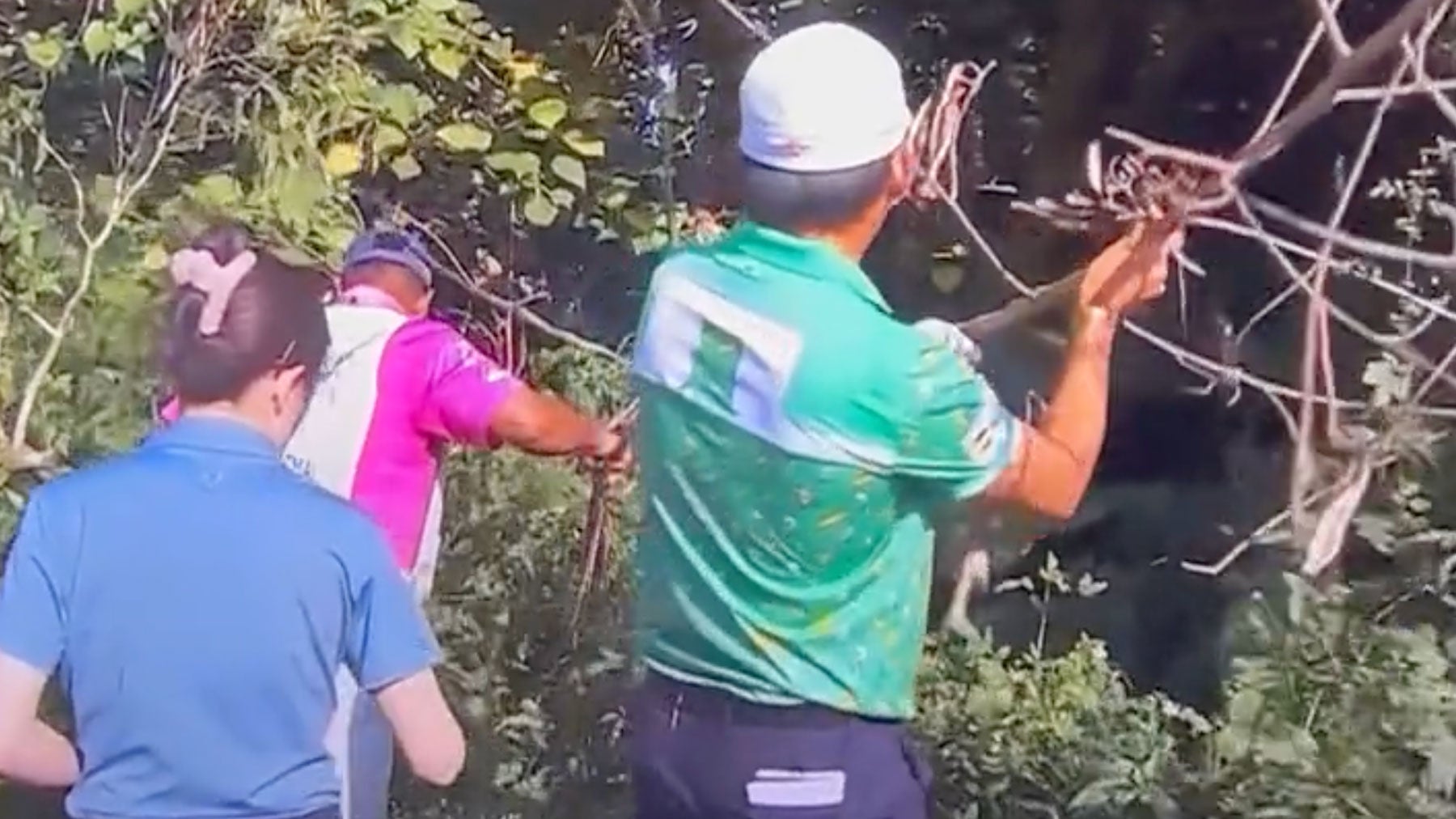‘A lot of headshaking’: Chaotic rules dispute triggers accusations, tension on Asian Tour
- Share on Facebook
- Share on Twitter
- Share by Email

Phachara Khongwatmai (in green) and his caddie (in pink) assessing his lie on the 16th hole at the Hong Kong Open on Sunday.
Asian Tour Media
The Hong Kong Open concluded Sunday with one of the tensest rules controversies of the year.
The dispute began when Phachara Khongwatmai of Thailand, then the leader by one, blocked his tee shot on the 16th hole at Hong Kong Golf Club into a snarl of trees and bushes right of the fairway. Filling out Khongwatmai’s group were LIV star Cameron Smith, who was one off Khongwatmai’s lead, and Ben Campbell of New Zealand, who was two back.
When Khongwatmai arrived at the area where his ball had disappeared, he ventured into the foliage to find it. Khongwatmai successfully located and identified his ball, but assessing whether he could get a club on it took far longer. As Khongwatmai and his caddie determined whether the ball was playable, they tugged on and pushed back branches and vines in the vicinity; the main obstructions were what appeared to be a large dead branch in his swing path as well as smaller branch nearer to his ball. A rules official also shuffled into the brush to examine Khongwatmai’s lie. The deliberation took nearly 20 minutes with Smith and Campbell closely policing the situation.
“The playing partners are clearly concerned,” Dougie Donnelly, a commentator for Asian Tour Media, said on the air. “It’s all becoming just a little bit chaotic. There’s a lot of headshaking going on.”
Not just headshaking — outright accusations of rules-breaking.
“He’s moving stuff all around it!” Campbell barked, as he pointed toward vines in front of Khongwatmai’s ball. Campbell also said to the presiding rules official, “He’s broken these branches here. Look at that, these just got broken … Wow.”
Smith also voiced protestations.
Seems Cam Smith agrees pic.twitter.com/3cq44T7PhJ
— Stephen Roche (@StephenRoche100) November 12, 2023
The rule in question was Rule 8.1a, which states that players cannot “take any of these actions if they improve the conditions affecting your stroke: move, bend or break any growing or attached natural object, or immovable obstruction, integral object or boundary object, or tee-marker for the teeing area when playing a ball from that teeing area; move a loose impediment or movable obstruction into position (such as to build a stance); alter the surface of the ground; remove or press down sand or loose soil; remove dew, frost or water.”
Khongwatmai, aware that Campbell and Smith were monitoring his actions, said to them: “You guys happy? If you’re not happy, I’m not going to do it.”
They most certainly were not happy, but the official ruled that Khongwatmai and his caddie had done nothing wrong. So Khongwatmai played away, dropping to his knees as he set up to try and hack his ball back to safety.
“He’s not thinking clearly,” a commentator said. “I really don’t think he is. This could go horribly wrong. His head must be in a mincer at the moment.”

But it actually went quite well, with Khongwatmai punching his ball to the edge of the fairway. He went on to make a double-bogey dropping him one back of Smith, who had made par. When Campbell birdied 17 and Smith and Khongwatmai made pars, the players arrived on the 72nd hole in a three-way tie.
Campbell played the closing par-4 masterfully, knocking his approach to 15 feet and holing his birdie try. Smith made par after a loose tee shot into the trees and finished solo second, while Khongwatmai three-putted for bogey to drop into a tie for third.
“Today my putting was not so good like the past three days, but I played well since the beginning until the 16th hole,” Khongwatmai said afterward. “I was in a very difficult situation at that moment that I couldn’t do anything. Also, there were broken trees, which was an obstacle so I couldn’t step backwards to drop the ball. I had to keep trying to hit it. However, I’m satisfied with my overall performance that I can make under par for today.”
Latest In News

Alan Bastable
Golf.com Editor
As GOLF.com’s executive editor, Bastable is responsible for the editorial direction and voice of one of the game’s most respected and highly trafficked news and service sites. He wears many hats — editing, writing, ideating, developing, daydreaming of one day breaking 80 — and feels privileged to work with such an insanely talented and hardworking group of writers, editors and producers. Before grabbing the reins at GOLF.com, he was the features editor at GOLF Magazine. A graduate of the University of Richmond and the Columbia School of Journalism, he lives in New Jersey with his wife and foursome of kids.









